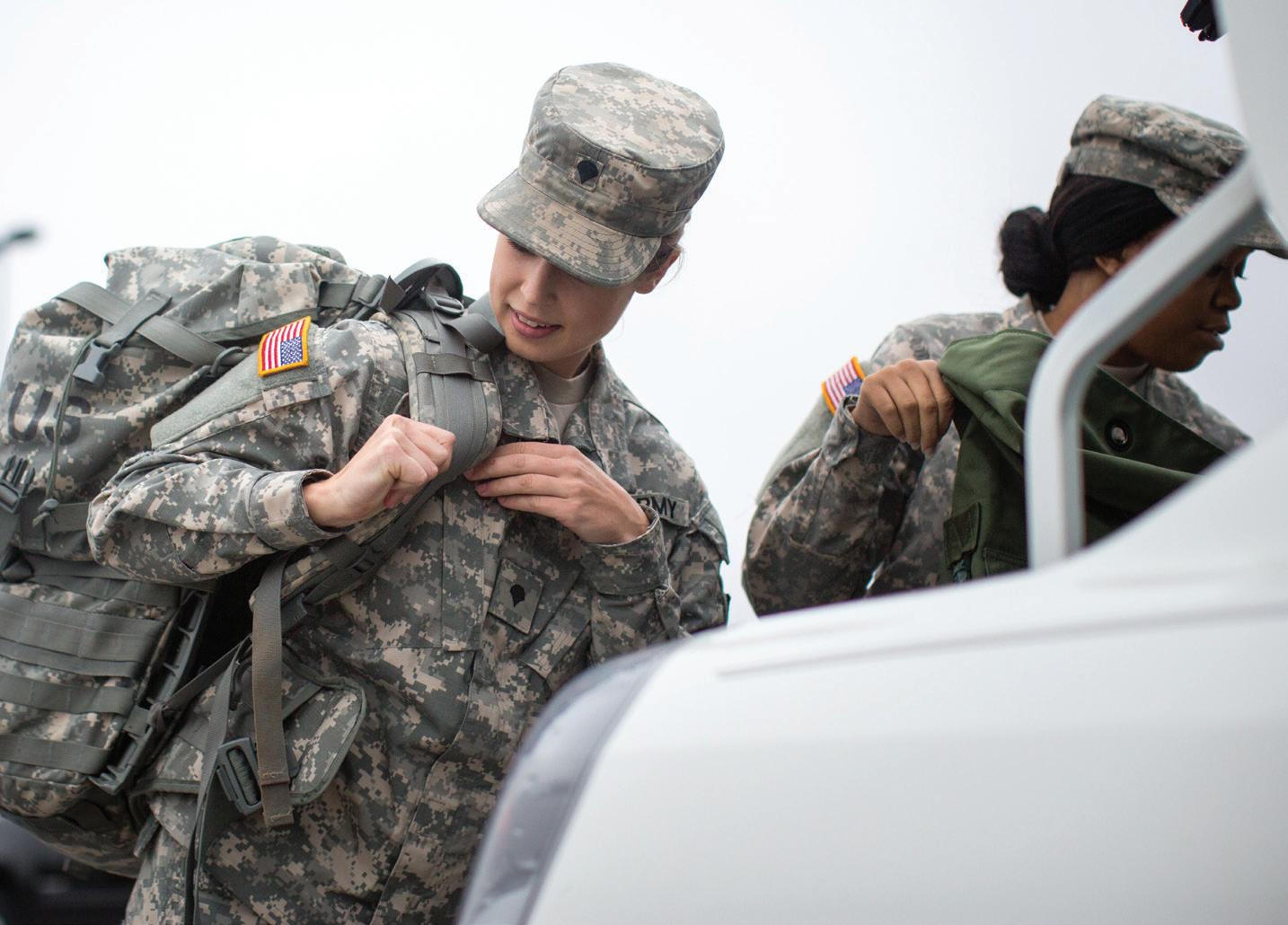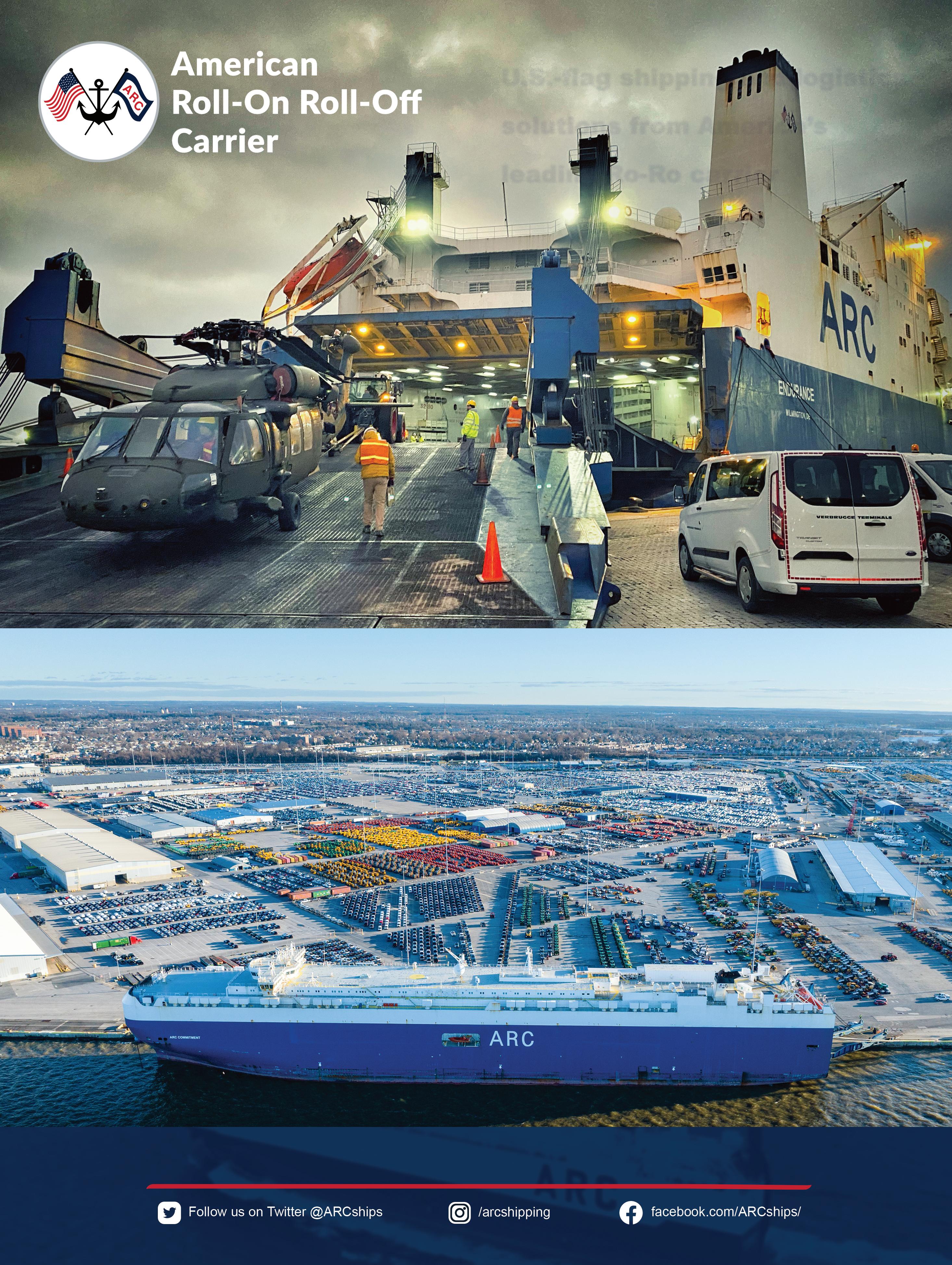The Official Publication of the National Defense Transportation Association February 2024 www.ndtahq.com Checking in with the Passenger Travel Industry CHECK IN




























• One of the industry’s largest van and platform selections with over 108,000 truck capacity providers in network
• Expedited cargo vans, straight trucks and tractor-trailers
• More than18,500 pieces of trailing equipment
• 10,300+ owner-operators leased to Landstar with over 1,200 stepdecks and 1,000+ flatbed trailers
• Drop and hook services
• Specialty trailers ranging from beam, blade and Schnabels to double drop, stretch and multi-axles
• Secure, dedicated government services with more than 350 AA&E secret cleared teams
• Hazmat certified owner-operators
• Unit moves with onsite carrier representative Look to Landstar for safe,





4 | Defense Transportation Journal | FEBRUARY 2024
on-time,
PROVIDES
SECURE,
CAPACITY PROVIDERS. Landstar System, Inc., 13410 Sutton Park Dr. South, Jacksonville, FL 32224 | 800-443-6808 LandstarGovtSvcs@landstar.com | www.landstar.com www.facebook.com/LandstarSystem www.linkedin.com/company/Landstar
LANDSTAR ADVANTAGE
claim-free capacity. A RECOGNIZED INDUSTRY LEADER, LANDSTAR
SAFE,
RELIABLE TRANSPORTATION SERVICES DELIVERED BY OUR UNIQUE NETWORK OF INDEPENDENT AGENTS AND
THE



February 2024 February 2024 • Vol 80, No. 1 PUBLISHER VADM William A. Brown, USN (Ret.) MANAGING EDITOR Sharon Lo | slo@cjp.com CIRCULATION MANAGER Leah Ashe | leah@ndtahq.com PUBLISHING OFFICE NDTA 50 South Pickett Street, Suite 220 Alexandria, VA 22304-7296 703-751-5011 • F 703-823-8761 GRAPHIC DESIGN & PRODUCTION MANAGER Susan Hill ADVERTISING SALES DIRECTOR Bob Schotta bschotta@cjp.com ADVERTISING & PRODUCTION Carden Jennings Publishing Co., Ltd. Custom Publishing Division 375 Greenbrier Drive, Suite 100 Charlottesville, VA 22901 434-817-2000 x330 • F 434-817-2020 Defense Transportation Journal (ISSN 0011-7625) is published bimonthly by the National Defense Transportation Association (NDTA), a non-profit research and educational organization; 50 South Pickett Street, Suite 220, Alexandria, VA 22304-7296, 703-751-5011. Copyright by NDTA. Periodicals postage paid at Alexandria, Virginia, and at additional mailing offices. SUBSCRIPTION RATES: One year (six issues) $40. Two years, $60. Three years, $75. To foreign post offices, $45. Single copies, $6 plus postage. The DTJ is free to members. For details on membership, visit www.ndtahq.com. POSTMASTER: Send address changes to: Defense Transportation Journal 50 South Pickett Street, Suite 220 Alexandria, VA 22304-7296 FEATURES TECHNOLOGY ADVANCEMENTS 10 IN LONG-TERM LODGING By Jeana Giordano PARTNERSHIP AT WORK 15 NDTA Industry Members Attend Joint Staff Command & Control Wargame By Marty Groover PASSENGER TRAVEL FOCUSED 18 A Conversation with Bryan J. Scott By Sharon Lo MEETING WITH PURPOSE 21 GovTravels Goes Carbon-Neutral By Sharon Lo MID SKILLS GAP 22 AAR Provides Collaborative Approaches to Solving the Aviation Mechanic Shortage THE NATIONAL DEFENSE INDUSTRIAL STRATEGY: 25 Enabling a Modern Defense Industrial Ecosystem DEPARTMENTS NDTA FOUNDATION HALL OF FAME 6 PRESIDENT’S CORNER | VADM William A. Brown, USN (Ret.) ................................................ 7 CHAIRMAN’S CIRCLE ........................................................................................................... 28 HONOR ROLL 29 INDEX OF ADVERTISERS 30 We encourage contributions to the DTJ and our website. To submit an article or story idea, please see our guidelines at www.ndtahq.com/media-and-publications/submitting-articles/. SIGN TODAYUP www.ndtahq.com/the-source The Source NDTA’sOfficialNewsletter Addpublications@ndtahq.com toyouremailaddressbook
NDTA Headquarters Staff
VADM William A. Brown, USN (Ret.)
President & CEO
COL Craig Hymes, USA (Ret.)
Senior VP, Operations
Claudia Ernst Director, Finance and Accounting
Lee Matthews
VP Marketing and Corporate Development
Jennifer Reed Operations Manager
Leah Ashe Membership Manager
Rebecca Jones
Executive Assistant to the President & CEO
Chloe Baker
Project Coordinator
For a listing of current Committee Chairpersons, Government Liaisons, and Chapter & Regional Presidents, please visit the Association website at www.ndtahq.com.
EDITORIAL OBJECTIVES
The editorial objectives of the Defense Transportation Journal are to advance knowledge and science in defense logistics and transportation and the partnership between the commercial transportation industry and the government transporter. DTJ stimulates thought and effort in the areas of defense transportation, logistics, and distribution by providing readers with:
• News and information about defense logistics and transportation issues
• New theories or techniques
• Information on research programs
• Creative views and syntheses of new concepts
• Articles in subject areas that have significant current impact on thought and practice in defense logistics and transportation
• Reports on NDTA Chapters
EDITORIAL POLICY
The Defense Transportation Journal is designed as a forum for current research, opinion, and identification of trends in defense transportation and logistics. The opinions expressed are those of the authors and not necessarily of the Editors, the Editorial Review Board, or NDTA.
EDITORIAL CONTENT
Archives are available to members on www.ndtahq.com.
Sharon Lo, Managing Editor, DTJ NDTA
50 South Pickett Street, Suite 220 Alexandria, VA 22304-7296 703-751-5011 • F 703-823-8761 slo@cjp.com
NDTA FOUNDATION HALL OF FAME
The National Defense Transportation Association Foundation recognizes our most special donors for their gracious financial support to academic scholarships supporting our future logistics and transportation leaders.
VISIONARY SOCIETY
Contribution over $100K
PATHFINDER SOCIETY
Contribution $25K - $49,999

ANNUAL DONORS
Award 2023
Patron Paramount Enterprises International, Inc.
Matson
Kalitta Air Enterprise Holdings Foundation
Advocate American Roll-On Roll-Off Carrier Group Inc.
Bristol Associates Interstate Moving | Relocation | Logistics
2024
American Roll-On Roll-Off Carrier Group Inc.
Matson
United Airlines
Interstate Moving | Relocation | Logistics
As the Foundation is funded by voluntary donations, with your support, the Foundation will be empowered to help students for decades to come. Please consider making a tax-deductible contribution to help our future professionals have a future. Visit https://www.ndtahq.com/foundation/ to find out more. GIVE HAPPY - The NDTA Foundation is now a vetted charity listed in Combined Federal Campaign! CFC charity code #94212
6 | Defense Transportation Journal | FEBRUARY 2024
FOUNDATION

As I write, the situation continues to boil in the Indian Ocean and Red Sea with Houthi attacks on commercial shipping— constraining international trade and movement—and placing the safety of mariners at risk. USTRANSCOM and the Navy’s Fifth Fleet have been outstanding partners in communicating with industry, which is much appreciated. Such communications continue to be vital to enable operations through contested environments. These latest, relatively small, but highly impactful, attacks to global logistics serve as yet another example and reminder of the in-
creasing need for logistics and transportation resilience in every domain: Sea, air, land, space and cyber. Resilience must be achieved in every phase of operations, including competition, crisis or conflict.
In every meeting I attend, I listen carefully to senior government and military leaders repeatedly confirming the importance of the logistics & transportation industry to our national security—and the need for our military and industry work together as partners. I do sense that this sentiment is sincere and will continue to evolve in positive ways over the next five
or so years. That said, there are still some considerable gaps in our logistics capacity, and command and control.
NDTA is committed to assisting with the closure of those gaps—and I appreciate the involvement of those on the


www.ndtahq.com | 7
CHAIRMAN’S CIRCLE
Leidos (upgrade) SUSTAINING
Taft Stettinius & Hollister LLP REGIONAL
Prime Trip Support UNIVERSITY
Christopher Newport University WELCOME NEW CORPORATE MEMBERS as of February 1, 2024 PRESIDENT’S CORNER Keep on Trucking VADM William A. Brown, USN (Ret.) NDTA President & CEO See Pres. Corner pg. 30 May 14-17, 2024 Christopher Newport University, Newport News, VA SURFACE FORCE PROJECTION CONFERENCE This conference focuses on CONUS strategic seaports, surface transportation modes, and unique challenges associated with operations in and through the contested environment now and in the future. The National Defense Transportation Association (NDTA) and Christopher Newport University’s Center for American Studies (CAS), along with the NDTA Surface Transportation Committee and Ports Subcommittee, partner with USTRANSCOM’s Military Surface Deployment and Distribution Command (SDDC), and Military Sealift Command, the U.S. Department of Transportation’s Maritime Administration (MARAD), the logistics and transportation industry, and academia to examine a wide range of challenges associated with deploying forces and moving sustainment to the point of need. Together we will build and strengthen our relationships, examine challenges, look for solutions, educate and collaborate, and find ways to improve readiness and capacity. REGISTER TODAY! www.ndtahq.com/events/sfpc/ “Ready Now – Contested Joint Force Deployments to and through Strategic Ports”
•
•
•
•
Travel Solutions
TAILORED FOR Government Entities
CTM is an expert in tailored travel management and fulfillment services supporting government travelers.
Our clientele represent excellence in state and federal government, higher education, aerospace, manufacturing, energy, defense contracting, international governments, and more.

We are your mission-ready, service-focused, and innovation-driven travel partner, delivering travel program solutions built on:

COMPLIANCE – meeting GSA data, security, and DEI regulations and objectives

EFFICIENCY – striking the perfect balance between exceptional service and user-driven innovation

SAFETY – managing traveler risk, budget optimization, and traveler purchase behavior
SUSTAINABILITY – reducing environmental impact with carbon reporting and offsetting
8 | Defense Transportation Journal | FEBRUARY 2024




www.ndtahq.com | 9 Contact us today to explore how CTM’s government travel management solutions can enhance your travel experience and support your agency’s mission. us.travelctm.com CTM is a proud Chairman’s Circle member of NDTA We can’t wait to see you at GovTravels! Meet us at Table 27.
Technology Advancements in Long-Term Lodging
 By Jeana Giordano, Global Director of Communications, ReloQuest
By Jeana Giordano, Global Director of Communications, ReloQuest

One advantage associated with a government lifestyle is the opportunity to travel and discover various parts of the world. This may involve an international excursion or a trek through a nearby national park during Temporary Duty Travel (TDY) or deployment. In the current global landscape, swift technological advancements profoundly influence various sectors, including international government and military travel. Government leaders are actively adopting new technologies, spearheading a transformative shift that impacts work processes, travel dynamics, and housing requirements.
The United States Federal Government
Government leaders are actively adopting new technologies, spearheading a transformative shift that impacts work processes, travel dynamics, and housing requirements.
and the Department of Defense (DOD) employ established tools for compliant airfares, rental cars, and hotel procurement. Each system ensures adherence to specific travel policies. Government agencies
utilize E-GOV Travel Services (ETS), a government-wide, web-based travel management service. ETS uses commercial best practices to enhance travel efficiency, providing a transparent, accountable, and sustainable service.
The DOD relies on the Defense Travel System (DTS), a travel hub enabling military members and DOD civilian personnel to book official travel and manage expenses. ETS aligns with the Federal Travel Regulations (FTR), while DTS adheres to the Joint Travel Regulations (JTR).
Despite policy distinctions, ETS and DTS source their inventory for airfares, rental cars, and hotels from the Global Distribution System (GDS). However, options for long-term lodging (LTL) fur-
10 | Defense Transportation Journal | FEBRUARY 2024


nished accommodations, suitable for extended stays, are unavailable in the GDS and thus inaccessible in ETS or DTS. The General Services Administration (GSA) introduced the long-term lodging contract to bridge this gap, ensuring ETS and DTS users have access to compliant long-term lodging from the GSA schedule to meet specific needs.
While travel can be stressful, the ongoing impact of technology on global travel continues to enhance accessibility, efficiency, and the overall traveler experience.
Most would agree that the seamless integration of both hotel and long-term lodging (LTL) options would deliver numerous benefits, such as enhanced flexibility in accommodation choices, a simplified booking process for travelers, greater costeffectiveness through optimized options, and an overall improved travel experience with choices tailored to individual preferences and needs.
Standard booking systems face challenges in keeping pace with the evolving landscape of corporate travel. Unified platforms such as ReloQuest offer distinct advantages, providing direct access to LTL-compliant options and enhanced compliance with travel policies while enabling streamlined communication, providing traveler alerts during assignments, and a cohesive experience through a single platform. Utilizing technology allows for gaining insights into travel expenses, enhancing Spending Under Management (SUM), and aggregating real-time program data.
While travel can be stressful, the ongoing impact of technology on global travel
continues to enhance accessibility, efficiency, and the overall traveler experience. Technological advancements offer realtime updates on LTL, optimizing the traveler experience and supporting efficient coordination throughout the trip.
This integration of processes for LTL travel expedites the entire search procedure, enabling travelers to receive availability information, pricing quotes, and essential details on multiple properties
an approach that involves leveraging new technology platforms to ensure a secure and efficient transition toward achieving the benefits of modernization. Technology integration significantly improves accessibility, efficiency, cost containment, Spend Under Management, and overall traveler satisfaction.
Unified platforms enable flexible and advanced configurations to create program efficiency and ensure compliance.

immediately. Travelers are presented with real-time LTL options, including rates— easily compared to per diem rates on one screen—property names, descriptions, features, amenities, distances to desired locations, interactive maps for nearby interests, and more. Self-service options allow travelers to make last-minute changes and adjustments to their bookings. This flexibility ensures that government travelers can control their arrangements and adapt to changing circumstances during extended stays.
The effective combination of technology and skillful cultural management consistently plays a crucial role in enhancing success rates. Leaders in charge of official LTL travel initiatives are likely to consider
Unified platforms enable flexible and advanced configurations to create program efficiency and ensure compliance.
Confirmed results demonstrate that using a single source platform to search for long-term lodging empowers government travelers in many ways. Technology delivers heightened levels of efficiency to enhance outcomes that contribute to an elevated travel experience, reduce costs, and
www.ndtahq.com | 11
increase spend under management. Realtime data enables travel managers to evaluate market trends, track spending, analyze overall program goals, and review supplier performance.
TECHNOLOGY SIGNIFICANTLY ENHANCES THE TRAVELER EXPERIENCE IN SEVERAL
WAYS:
Communication encompassing critical aspects of their travel journey may include mobile applications that enable seamless and efficient long-term bookings, expedited check-ins, and alerts, as well as providing comprehensive information about lodging, local amenities, services, and attractions.
Direct access to availability and online booking for LTL travel requirements saves time and gives travelers a broader range of options, making comparison easier. Extension requests are processed online to expedite the booking process.
This simplifies the logistical aspects of longterm lodging and empowers government personnel to make informed decisions, fostering a sense of control and comfort during their extended travel periods.
In essence, a cohesive platform that delivers real-time information and is compatible with mobile technology offers government travelers seeking long-term lodging an elevated level of engagement, efficiency, and customization. These advancements address practical concerns related to bookings and check-ins and contribute to a more enriching, tailored experience for government individuals navigating longterm lodging while away from home.
QUESTIONS TRAVEL MANAGEMENT SHOULD CONSIDER
• Why is a long-term lodging technology necessary for sourcing GSA-approved LTL vendors?
• How does the technology simplify the booking process for government travelers, offering a user-friendly interface to search, compare, and book furnished accommodations?
• Does the technology provide access to a GSA supplier network?
• Does the technology feature GSA Per Diem Rates integration, providing options within approved budget limits?
• Can platform users identify and select certified suppliers from the GSA?
• Can government travelers stay informed, make data-driven decisions, and easily adjust their plans?
• Can travelers access real-time housing information, enabling travelers to make informed decisions?
• Can travelers receive real-time updates on travel-related questions?
• Does the technology provide features such as DirectConnectSM to service contacts?
LONG-TERM LODGING, ITS USERS, AND BENEFITS
Access to GSA Certified Supplier Network: Technologies such as ReloQuest allow platform users to select housing from certified GSA long-term lodging suppliers or from the platform’s verified network of suppliers, depending upon configurations and program policy. Search, compare, and book LTL-furnished accommodations from professionally managed suppliers. The GSA per diem rates are integrated so travelers can easily choose an option and remain compliant.
STANDARD USER SCENARIOS WHERE LTL FOR A 30-NIGHT STAY IS APPROPRIATE
• US Navy Shipyard Workers—PSNS, PNSY, PHNS, NNSY
• Intern/pathways programs—USDA (multiple), DOI, DOT, USN NADP
• Fellows programs—DC
• Training—FLETC, SOCOM, NTC, DOD, etc.
• Mission critical—CBP, DOD
• Relocation—MIL PCS
• Relocation—Repatriation after overseas assignment
• Relocation—Assigned to an overseas area
• Foreign correspondents
TYPICALLY INCLUDED IN LONG-TERM LODGING
• A home-like environment
• Fully furnished accommodations
• Kitchen housewares, tableware, full amenities, electronics, and small appliances
• Linens and accessories
• Wifi, phone, cable TV
INFORMATION ACCESS
Traveler accessibility to real-time information about destinations, accommodations, and transportation. Innovation allows for better trip planning, enabling travelers to make informed decisions. Initiate service requests with visibility into progress.
BOOKING AND RESERVATIONS
Direct access to availability and online booking for LTL travel requirements saves time and gives travelers a broader range of options, making comparison easier. Extension requests are processed online to expedite the booking process.
Data analytics and business intelligence to support LTL programs:
Initiative: Leveraging data analytics and business intelligence tools to gain insights into travel patterns and preferences.
Benefits: Make data-driven decisions, optimize travel plans, and enhance the entire travel experience.
Benefits: Simplification—everyone has a standard protocol via one resource. Ensures employees know and utilize the latest policies. Technology per organizational guidelines.
Jeff Mahoney, ReloQuest COO, stated, “Technology is integral to our daily lives and professional responsibilities. The key to successful technological deployment is establishing a structured policy-compliant solution within organizations. ReloQuest prioritizes innovation, maintaining a pipeline aligned with our clients’ objectives, ensuring our ongoing commitment to functionality, and continuing to elevate the client and traveler’s experience.”
Technology has ingrained itself into our lifestyles, keeping everyone interconnected. The ReloQuest platform provides travelers with consistent, real-time housing options that include rich content, such as rates
12 | Defense Transportation Journal | FEBRUARY 2024

(compared to per diem), property name, description, features, amenities, distance to the desired location, interactive maps to search nearby interests, and much more. Everything any traveler needs is accessible, all in one place, including live, 24/7/365 DirectConnectSM customer support.
As technology becomes increasingly central to the long-term lodging landscape, the future holds great promise for addressing the specific needs of government-sponsored travelers, ensuring a seamless and enriching experience throughout their extended journeys.
Jason Moore, VP of Government Business Development for ReloQuest and a USN Veteran, stated, “To best serve travelers and travel buyers, the industry must provide the ability to search, compare, and book GSA-approved longterm lodging on a self-service technology platform and transform the government travel space around LTL procurement. Utilizing an LTL aggregating technology platform to simplify and centralize
the booking of compliant LTL is the key to providing a Best in Class Solution for the US Government.”
Integrating Artificial Intelligence (AI) into the long-term lodging sector is reshaping the dynamics of extended stays and government-sponsored travel. Fueled by innovation, this transformative shift represents a significant evolution within the lodging industry, particularly in supporting government travelers requiring long term lodging.
The resulting benefits will streamline logistics and contribute to developing a sustainable and supportive infrastructure for long-term government travelers. A culture of continuous innovation offers valuable assistance to government travelers from their initial preparation through the duration of their extended stays.
As technology becomes increasingly central to the long-term lodging landscape, the future holds great promise for addressing the specific needs of governmentsponsored travelers, ensuring a seamless and enriching experience throughout their extended journeys. Anticipating and investing in advancements that include longterm stays will undoubtedly contribute to the success and satisfaction of individuals undertaking extended travel assignments.
ELEVATING ENGAGEMENT
The evolving travel and hospitality landscape presents opportunities for enhanced engagement and tailored experiences for government travelers seeking long-term
lodging. AI significantly contributes to this domain, seamlessly integrating into the customer service landscape. Government personnel on extended assignments can benefit from solutions that provide responsive and efficient assistance throughout their stay. These technologies contribute to a more personalized experience by understanding individual preferences and needs.
The growing reliance on mobile technology is particularly relevant for government travelers seeking long-term lodging. The convenience of a technology platform compatible with smartphones ensures a smooth and adaptable travel experience.
• Self-Service Capabilities: Are self-service options available, allowing travelers to make last-minute changes and adjustments to their bookings? This flexibility ensures government travelers can control their arrangements and adapt to changing circumstances during their extended stays.
• Government travelers often require longterm lodging for extended assignments. Not all platforms offer various options, including apartments, condos, houses, and hotels suitable for extended stays.
DATA ANALYTICS AND BUSINESS INTELLIGENCE
A platform should utilize data analytics and business intelligence tools to gain insights into travel patterns and preferences. This information can be valuable for government agencies to optimize travel plans, make data-driven decisions, and enhance the over-
www.ndtahq.com | 13
all efficiency of their travel programs.
A comprehensive and technology-driven solution can make the process of securing long-term lodging for government travelers more efficient, cost-effective, and tailored to their specific requirements.
ACCESS TO A CERTIFIED SUPPLIER NETWORK
Not all technologies have equal functionalities and features. Utilizing technologies like ReloQuest enables users to choose housing from suppliers certified by the General Services Administration (GSA). This ensures that accommodations align with the compliance standards set by the GSA, offering a versatile reference point.
SIMPLIFIED BOOKING PROCESS
A platform that streamlines the booking process for various travelers, providing a user-friendly interface to explore, compare, and book furnished accommodations is an asset
as it saves time and ensures effectiveness in securing long-term lodging to best meet individual needs at a cost-effective price.
REAL-TIME INFORMATION AND UPDATES
Access to real-time information about destinations, accommodations, and transportation enhances travelers’ ability to stay informed. This feature empowers users to make data-driven decisions and promptly adjust their plans based on the latest updates, promoting a smooth and adaptable travel experience.
COMMUNICATION AND COLLABORATION
A platform should foster communication and collaboration among all users, including global long-term lodging suppliers and travelers. This ensures that government travelers have access to accommodations that meet the necessary compliance standards set by the

GSA. Seamless interactions, quick response times, and effective coordination enhance the overall experience for travelers.
In conclusion, innovative technology significantly enhances the travel and lodging benefits for military and government travelers. The commitment to efficiency and an improved traveler experience is evident in the measures taken by the US Federal Government, the DOD, and the GSA.
The GSA’s Long Term Lodging contract effectively addresses the crucial gap of identifying compliant long-term lodging providers for ETS and DTS users. As technology continues to shape the future of long-term lodging, strategic upgrades are poised to further enhance the success and satisfaction of government-sponsored travelers during extended assignments— and utilizing available unified platforms will prove key to providing a streamlined, cohesive experience. DTJ
14 | Defense Transportation Journal | FEBRUARY 2024
©2023 Enterprise Rent-A-Car. The ”e“ logo and Enterprise are registered trademarks of Enterprise Holdings, Inc. L00771 PROUD TO SERVE THOSE WHO SERVE ® Enterprise Founder Jack Taylor (back row, far right) and fellow Navy pilots during WWII Learn more at enterprise.com/military At Enterprise, our commitment to the military has been around from the very beginning. It started with the values our founder, Jack Taylor, learned in the Navy while serving on the USS Enterprise during World War II and continues to this day. From the convenience of renting directly on a US military base to our low-touch transactions, we’re ready whenever service members are.

Partnership At Work:
NDTA Industry Members Attend Joint Staff Command & Control Wargame
By Marty Groover, NDTA Technology Subcommittee Chairman
In early November 2023, Joint Staff J-4 (J4) leaders reached out to NDTA’s Senior Vice President of Operations, Craig Hymes. Recognizing the invaluable expertise of the Association’s members, the J4 enlisted the participation of industry experts from transportation, logistics, and passenger travel to support a three-day, classified level Command and Control (C2) Support Command Relationship (COMREL) tabletop exercise (TTX) in Alexandria, Virginia.
Eight NDTA industry partners—Lars Magnusson from APL, Matthew Gehrling from Liberty Marine, Sean Moroney from Matson, Bleu Hilburn from Crowley, Anderson Nowling from The Pasha Group, Ameed Micko from American Roll-On Roll-Off Carrier, Dan Boehler from Omni Air International, and Marty Groover from C5MI—attended the exercise which took place 12-15 December 2023.
The goal of the exercise, as articulated by J4-Chief of Defense Industrial Base (DIB) & Logistics Services LTC Sandra (Roshanda) R. Thomas, was to foster a unity of effort among the Services, Combatant Commands, agencies, partner nations, and nongovernmental organizations. This uni-
ty, which the group successfully achieved, requires a comprehensive understanding of the Joint and Partner C2 structures, and of the associated authorities and responsibilities supporting the INDOPACOM region.
The National Military Strategy (NMS),
Joint Concept for Logistics (JCL), and Joint Concept for Contested Logistics (JCCL), as part of the Joint Warfighting Concept (JWC), rely on Joint Logistics Enterprise (JLEnt) to provide real-time visibility and allow for timely adjudication of limited resources. The JLEnt is a

www.ndtahq.com | 15
Pictured (L-R) Anderson Nowling, Marty Groover, Matthew Gehrling, Sean Moroney.
Joint Logistics Enterprise (JLEnt)


complex provider network that executes end-to-end logistic operations from procurement sourcing, warehousing, and global transportation to the warfighter. To manage the complexities of the JLEnt, the partner authorities in the C2 relationships must be fully mapped and understood to ensure there is no guesswork in supporting the execution of the Combatant Commander’s (CCDR) operational plans. The Defense Industrial Base is a critical component of the JLEnt, which is why the Joint Staff wanted to include NDTA industry partners in the exercise.
Industry partners provided foundational background information on day one, including reviews of the five domains of warfare and demonstrations of Logistics Common Operational Pictures (LOG COP) that will be needed to support C2 at speed for decision dominance. The foundational information allowed the industry partners to give their opinion on the DIB portion at the out briefs for each scenario from competition to crisis and then conflict.
The Joint Concept for Logistics (JCL) proposes a concept for how the joint logistics enterprise (JLEnt) could support globally integrated operations in the 2020-2034 timeframe. It entertains three basic questions about the future:
• What if the challenges of globally integrated operations fully are implemented and the extrapolation of current trends into the future render the current approach to joint logistics inadequate?
• How might the JLEnt meet that challenge?
• What capabilities would it need beyond those that exist today?
Industry partners were spread across the three logistics break-out areas for Class V munitions, Class IIIB Petroleum, and
General Distribution. They were integrated with the break-out teams and provided feedback on the C2 authorities and opportunities for improvements included in the final report to senior leaders at the conclusion of the exercise. Based on LTC Thomas’s comments, this was the first time that industry partners were included in a classified exercise, and based on the feedback, she stated that the Joint Staff wanted to continue to include them in future events.
The NDTA members who attended volunteered for the exercise and funded the participation of their representatives in the event. Feedback from industry partners was positive. From their perspective and as part of the JLEnt, including them in creating a cohesive network to support the warfighter in a contested logistics environment is imperative. Their participation in the exercise not only contributes to the mission and goals of the NTDA, but also provides them with valuable insights and opportunities for collaboration—demonstrating the value they bring to the JLEnt. DTJ
16 | Defense Transportation Journal | FEBRUARY 2024
Image courtesy The Joint Staff


When your mission depends on freight, you can depend on
Crowley crowley.com/dfts
www.ndtahq.com | 17
CARRY THE WORLD. FORWARD.
Passenger Travel Focused: A Conversation with Bryan J. Scott
By Sharon Lo, Managing Editor, DTJ & The Source

The GovTravels Symposium is just around the corner. This annual event, co-sponsored by NDTA and the Defense Travel Management Office (DTMO) and held in association with the General Services Administration (GSA), will occur at the end of February in Alexandria, Virginia. In preparation for the conference, DTJ sat down to chat with one of the key leaders of the event—Bryan J. Scott, Chairperson of the NDTA Government Passenger Travel Advisory Council (GPTAC), and Assistant Vice President of Government Business at Enterprise Holdings.
During our chat, Mr. Scott provided background on the GPTAC, details about its committees, and shared a rundown of what GovTravels attendees can expect this year. We also had a chance to discuss some exciting new initiatives recently unveiled by Enterprise, as well as his insights into the rental car industry as a whole.
DTJ: First things first, for those readers who may not be familiar with it, can you tell us a little bit about the Government Passenger Travel Advisory Council?
SCOTT: Sure, the GPTAC was created by NDTA and industry to provide an open, collaborative forum between government entities and the travel industry to exchange ideas, analyze trends and policies, and work to improve common travel issues.
Its primary goals are threefold: To encourage, promote, and foster new avenues
for research, collaboration, and knowledge sharing about government travel industry trends; to use evaluation and research data to inform and foster an environment of continuous improvement and growth between government travelers and industry members; and to provide regular forums where industry and government agencies can collaborate on priorities established by the GPTAC.
DTJ: I know the Council is comprised of several Committees—can you tell us a little about the Committees?
SCOTT: The Committees are really the heartbeat of GPTAC. They act as a central voice to the membership and government stakeholders. Each Committee is comprised of volunteers from the travel industry. These folks are unquestionable leaders in their segments in terms of knowledge of the industry and government programs they support. These leaders contribute to discussions and engage with industry and government collaborators.
A great example of the committees’ value was demonstrated in the industry’s response to the COVID-19 pandemic. The
18 | Defense Transportation Journal | FEBRUARY 2024
Committees maintained constant communication with all parties to ensure government was able to mobilize and travel at a time when supply lines and resources were compromised.
In terms of how we are organized, I lead the Council as Chairman alongside my Vice Chair Greg Harkins. And then for the Committees we have Michael DeRosa leading the Car Rental Committee, Marlene Gray leading the Travel Management Companies Committee, Jason Moore leading the Long Term Lodging Committee, Lauren Gibson leading the Bus Committee, Chris McLaughlin leading the Hotel Committee, and Evan Koppel leading the Airline Committee.
DTJ: GovTravels is coming up. What role does the Council and its Committees play in that event and what can attendees expect this year?
SCOTT: The Committee Chairs play a vital role in the planning and content creation for GovTravels. The planning for this year’s event started shortly after the conclusion of GovTravels ’23. Our members actively participate in determining the agenda for the event and keynote speakers, based on feedback and current industry issues.
The theme of this year’s event is The Future of Government Travel: Trends in Sustainability, Innovation and Evolving Technologies. Keynotes will be focused on the rapid advancements in innovation,

technology, and sustainability, and their positive impacts on the customer travel experience.
DTJ: Wow, that sounds like it’s going to be a really valuable event. I have to admit, each time I attend it feels like GovTravels is bigger and better than ever.
SCOTT: All credit for the growth of GovTravels goes to NDTA, DTMO, GSA,

and industry leadership. We have exceeded expectations every year, and expect attendance this year to be the largest on record. It’s a testament to the value of the event to those who participate. It truly is a oneof-a-kind event—the largest collection of government and industry travel experts coming together to ensure our managed travel programs remain best in class and are positioned to allow our government to succeed in their missions.
DTJ: Well, I’m definitely excited to attend. Speaking of exciting, I’ve heard there are a lot of exciting things going on at Enterprise. Can you tell us some of what you all have been up to?
SCOTT: We are firing on all cylinders to serve our customers around the world across the full spectrum of their transportation needs. And, as we look to help shape the future of mobility, we are connecting the business’ full portfolio of offerings under a new corporate brand – Enterprise Mobility.
I’m really excited about this. I recently celebrated my 35th anniversary with Enterprise with the past 18 working with the Federal Government. And, for the majority of my tenure, we have been best known as the world’s largest car rental provider. Yet, the business has evolved immensely in
www.ndtahq.com | 19
Bryan Scott welcomes attendees to the 2023 GovTravels Symposium.

terms of geography, offerings, and customer segments we serve. Today, we operate in more than 90 countries and territories, and serve customers across nine mobility offerings including car rental, fleet management, carsharing, vanpooling, car sales, truck rental, and a number of technology solutions. “Enterprise Mobility” represents more fully who we are and what we have to offer today.
DTJ: Interesting, and what will these changes mean for your customers?
SCOTT: Our corporate brand is changing—but who we are, and what our customers know us for, is not. The Enterprise Mobility portfolio of brands, including Enterprise Rent-A-Car, National Car Rental, and Alamo will remain unchanged as key offerings.
The motivation behind this announcement is to bring together the power of our full mobility portfolio as we continue to invest significantly to deliver leading customer service and experiences.
As Enterprise Mobility, we will stay true to the values we’ve held since our founding that guide how we do business and how we give back to communities. We will maintain the same culture of exceptional service, always putting our customers first. We will constantly innovate so we can deliver people-first experiences in the rapidly evolving area of mobility. And, we will continue creating meaningful connections—with our customers, our business
partners, and across industry, so we can keep moving mobility forward together.
DTJ: That’s great to hear. In terms of the overall car rental industry what are the trends you are seeing and how does what you are doing relate?
SCOTT: The mobility industry is changing rapidly as the world evolves toward transportation solutions that are more efficient,
Mobility, we are approaching those changes in a mindful way.
We are implementing new technology experiences that are personalized, digital, connected, and on-demand.
We are also working to help our customers integrate the latest vehicle technologies in the right way for them. Our fleet management business, for example, recently provided more than 1,100 custombranded 2023 Chevy Bolt electric vehicles at select Domino’s franchise and corporate stores, making it one of the largest all-electric food delivery fleets in the country. We take care of vehicle acquisition, financing, telematics solutions, and maintenance, while Domino’s realizes the benefits of an EV fleet such as zero tailpipe emissions, advanced safety features, and lower average maintenance costs than non-electric vehicles.
DTJ: Bryan, thank you so much for your time and thoughts today. Before we go, is there anything else you wanted to share with DTJ readers?
SCOTT: I’d like to offer a big thank you to the NDTA, the GPTAC membership, and our government partners for all their support. Not only for this event, but also for their efforts throughout the year to foster

convenient, sustainable and technologyforward. Those changes are transforming the ways we move, commute, and interact with the world around us. At Enterprise
new avenues of collaboration and knowledge share. It’s truly humbling to represent an industry that is so focused and committed to supporting the US Government. DTJ
20 | Defense Transportation Journal | FEBRUARY 2024
Meeting with Purpose: GovTravels Goes Carbon-Neutral
By Sharon Lo, Managing Editor, DTJ & The Source
As final touches are prepared for the 2024 NDTA-DTMO GovTravels Symposium, NDTA is pleased to announce that some important new plans have been laid for this year’s event. The conference hotel and venue, the Hilton Alexandria Mark Center Hotel, has agreed to fund the carbon offset that will enable the Symposium to be carbon-neutral for the first time—an act that feels even more apropos given this year’s meeting theme, “The Future of Government Travel: Trends in Sustainability, Innovation, and Evolving Technologies.”
Hilton partnered with ClimeCo to develop a portfolio of high-quality carbon offsets for customers hosting meetings or events at its hotels. Recognizing the responsibility to empower customers to achieve their Environmental, Social and Governance (ESG) goals through more sustainable offerings, Hilton began offering a program called Meet with Purpose. The program enables planners to first make selections for an environmentally responsible and sustainable meeting or event, and then provides a carbon offset
option to deliver carbon-neutral meetings at participating Hilton properties around the world.
Using Hilton’s proprietary ESG management platform, LightStay, Hilton sales professionals calculate the carbon emissions associated with a meeting or event and then purchase carbon offsets from ClimeCo, a third-party verified and registered through the Climate Action Reserve or Verified Carbon Standard. Carbon offsets are used in a variety of ways including using compostable products to generate energy, improving local energy generation through wind and water power, and reducing Nitrous Oxide (N20) which is a significant contributor to global warming.
The Hilton Alexandria Mark Center is proud to take part in such important initiatives. In addition, the hotel participates in a host of other sustainability activities, including a robust recycling program:
• Kitchen Grease – The hotel recycles its cooking oil. The oil is cleaned through a 3rd party, so it is reusable.
• Batteries – All batteries in the hotel from door locks, remotes, etc. are re-
cycled through its waste management program.
• Cardboard, White Paper, Glass/Bottles – These items are also recycled through the hotel’s waste management program.
• Lightbulbs – The hotel uses a machine to crush its light bulbs so they can be reused in some capacity. When the machine gallon is full, it consistently starts the process over.
• Laundry Recycle Water – The water used in the hotel washing machines is pushed through a recycling system so that it can be thoroughly cleaned and reused.
• Mattresses – The hotel recycled its entire mattress inventory during the process of installing new ones.
The theme of this year’s meeting is meant to focus us forward, challenging us to consider new developments in passenger travel within the context of protecting and preserving the environment. As we prepare to welcome the GovTravels attendees, we look forward to showcasing how we can all be a part of the solution.







www.ndtahq.com | 21
DTJ © 2023 Hilton Confidential and Proprietary SUSTAINABLE MEETING TIPS FOR THE INDIVIDUAL TRAVELER TRAVEL WITH PURPOSE GO MOBILE! It’s easy (and convenient!) to access your boarding pass, check in to your hotel room and receive a hotel folio directly from your phone. DON’T FORGET REUSABLES Many hotels, airports and destinations offer water stations to fill up your reusable water bottle. OPT FOR ALTERNATIVE WHEELS Consider booking a direct flight or renting an electric vehicle to reduce your carbon footprint from transportation. CHOOSE SUSTAINABLE HOTELS Stay with hotel chains that are committed to redefining sustainable travel. Hilton is the first major hospitality company aligned with the Paris Climate Agreement. PLAN Review the protocols/requirements for destinations you are traveling to and the transportation you will take so you are prepared. Book travel ahead to ensure the most efficient and cost effective options. Allow for extra time to ensure a more seamless experience. BUY LOCAL AND SHOP SMALL The best way to support – and get to know – a city or community is to contribute directly to the local economy. Need a recommendation? Use your Hilton Honors app for curated local suggestions. BE PATIENT Be cognizant of those around you, respect peoples’ comfort level, a hand shake or hug may be replaced with an elbow bump as you travel and when you return home as you re-connect with family and friends.

MID SKILLS GAP
AAR Provides Collaborative Approaches to Solving the Aviation Mechanic Shortage

For 20 years, aviation executives and higher education officials have warned that an acute shortage of aircraft maintenance technicians (AMTs) could slow expansion and modernization of the global airline fleet. Lack of awareness of mid-skills aviation careers and training programs continues to be the No. 1 barrier to growing an influx of talent as the AMT workforce rapidly ages and retires.
“Mid skills” is a term used to describe careers that require industry certifications but not a college degree, including aviation mechanics. Recognizing the importance of gathering information on the state of mid skills talent development efforts and providing tangible recommendations for collaboration, AAR launched its first mid skills gap report in 2011. That year, the average age of an AMT was 47. Today, it’s 53, which is 11 years older than the average US worker as reported by the US Bureau of Labor Statistics. Since that time AAR has released two subsequent reports in 2018 and, most recently, in late 2023.
Our research show that industry-wide, employers are investing in training through public-private partnerships with technical schools, two- and four-year colleges, and proprietary colleges. They are recruiting talent from diverse communities, tapping traditionally underrepresented groups, notably women and people of color, to fill the pipeline. However, these efforts tend to be siloed and narrowly crafted to meet the talent needs of a single company or geographical region, not as an overarching, sustainable solution industrywide.
Meanwhile, most of the nation’s 196
aviation maintenance training schools, which we’ll refer to as A&P (airframe and powerplant) schools, are operating at just over half capacity. A faculty shortage at training schools is the second largest barrier cited by industry officials to growing talent.
The fact is an experienced technician can make more money working in the industry than teaching. Entry-level salaries have risen in the last two years by nearly 20
$100,000 a year with five years on the job.
In aviation, the early days of the COVID-19 pandemic precipitated work slowdowns, mass layoffs, and employee furloughs. Requests for new aircraft orders were put on hold but only temporarily. Airlines and MROs have begun to reactivate their lofty expansion plans as the industry rebounds, but they are running up against an unwillingness by employees to return to work.
Some have moved on to other companies, switched careers, or retired early to spend time with family. In some cases, they left to avoid COVID-19 testing and vaccine protocols imposed on federally regulated industries, like aviation. In all, the industry lost an estimated 5,000 potentially new mechanics since the pandemic began.
Forecasts predict the global aviation market will need 690,000 new mechanics to maintain the global fleet over the next 20 years. For that to happen, enrollment in A&P schools must grow by 20 percent annually.
It’s currently growing at two percent a year. That rate is unlikely to improve without: a) a concerted national effort to create

percent due to fierce competition for talent among major airlines, regional carriers, and aftermarket companies like AAR. An A&P certificated mechanic can earn a median annual salary of $65,380 or $31.52 an hour. At AAR, they can earn upwards of
robust high school feeders supported by general aviation curriculum into A&P programs; and b) more collaboration between industry, educational institutions, and nonprofits to design and replicate successful pathway models for the benefit of all.
www.ndtahq.com | 23

Despite these challenges, aircraft repair stations stand to leverage unprecedented growth in the industry defined by new aircraft orders, rebounded travel and tourism, parting out of legacy aircraft, and updated FAA education and training protocols more aligned with the advanced technical skills in demand today.
The aerospace industry is a key indicator of global and domestic economic health. But planes cannot fly safely without people skilled in their ongoing maintenance and repair. The delays and inconveniences travelers have experienced over the previous two years will worsen if major airlines, regional carriers, and the business aviation sector are forced to park aircraft because there aren’t enough mechanics to work on them.
When the airlines lose money, those costs are passed on to consumers. Yet, just as major airlines are moving ahead with expansion plans despite the paucity of pilots and crew members, at AAR we are building capacity to accept new lines of maintenance at two of our four US repair stations.
AAR has taken several collaborative steps since 2019 to solve our own workforce challenges that we believe can be replicated and also supported by state and federal grant funding. We recommend the industry adopt similar strategies and work collaboratively to resolve the aircraft mechanic shortage on a broad scale. With this
approach, we all win.
The following are key issues facing the industry and our recommendations on how to begin solving them.
LACK OF AWARENESS OF AVIATION CAREERS
Industry, government, and education should work together to launch a national campaign to raise awareness of aviation careers that are rarely talked about in the public sphere.
REDESIGNING CURRICULUM TO MEET NEW FAA PART 147 STANDARDS
A&P schools should begin addressing elements of the certification standard and seek guidance from industry partners to align the curriculum to current demands.
NEW A&PS AREN’T KEEPING PACE WITH DEMAND
Update the FAA regulations to allow AMT candidates who complete a general aviation curriculum, like Choose Aerospace, in high school to take the FAA general exam to become certified. Under the current regulations, for instance, a candidate seeking a pilot’s certification is eligible to take the exam upon completion of the general aviation curriculum, but aspiring mechanics are not. Completing the exam early would expedite the process and lead to increased certifications across the aviation industry.
DIFFICULTY HIRING FACULTY
Recruit retired AMTs as instructors. Build training programs to teach people with industry experience how to instruct others. This could be done by providing resources to build a training module on the art of teaching in an FAA-certificated school.
LOW A&P SCHOOL ENROLLMENT
Create robust high school feeder programs leveraging Choose Aerospace starting in the junior year. These types of programs are a natural marketing arm of the school and can, therefore, grow organically. A&Ps with these types of partnerships report low attrition and increased career awareness in their communities.
LIMITATIONS ON RECRUITING TALENT GLOBALLY
Lawmakers must pass common-sense immigration policies that allow aviation companies to recruit talent from abroad to meet demand and keep airplanes flying safely. Similar to aircraft pilot and crew shortages, mechanics shortages have the potential to cause flight delays and price hikes if airlines are forced to take planes out of service.
These processes won’t happen overnight. There is much work to be done in the coming years. The goal of AAR’s MidSkills Gap report is to show that the challenges ahead can be overcome if industry employers act collaboratively, creatively, and above all, urgently. DTJ
For more insights, read the full report at www.aarcorp.com/globalassets/6.-careers/students/aar-2023-mid-skills-gap-report.pdf.

24 | Defense Transportation Journal | FEBRUARY 2024

The National Defense Industrial Strategy: Enabling a Modern Defense Industrial Ecosystem
With the publication of the 2022 National Defense Strategy (NDS), Secretary of Defense
Lloyd J. Austin III charted the Defense Department’s way forward through today’s “decisive decade.”
Increasingly coercive actions taken by the People’s Republic of China demonstrates its intent to reshape the lndo-Pacific region and broader international system to fit its authoritarian preferences, and the Russian Federation’s invasion of Ukraine underscores the acute threat it poses. These threats, along with transboundary challenges like COVID-19, demonstrate the imperative for increased and improved
defense capabilities for both the United States and our allies and partners.
The NDS states that the US will prioritize coordinated efforts with the full range of domestic and international partners in the defense ecosystem to fortify the defense industrial base, our logistical systems, and relevant global supply chains against subversion, compromise, and theft. To do this, the Department of Defense (DOD) has released its firstever National Defense Industrial Strategy (NDIS). The NDIS will catalyze generational change from the existing defense industrial base to a more robust, resilient, and dynamic modernized defense industrial ecosystem.
PRIORITY 1 | Resilient Supply Chains
The DIB can securely produce the products, services, and technologies needed now and in the future at speed, scale, and cost.
The NDIS lays out four long-term strategic priorities to serve as guiding beacons for industrial action and resource prioritization in support of the development of this modernized defense industrial ecosystem.
The NDS defines resilience as the ability to withstand, fight through, and re-
www.ndtahq.com | 25
US Navy photo by Mass Communication Specialist 2nd Class Jackson Adkins.
cover quickly from disruption. Dynamic production is primarily concerned with managing production processes and capacities to meet the changing demands of our warfighters, allies, and partners at speed and at scale. Resilient supply chains and dynamic production share the goals of adaptability, responsiveness, and scalability. The near-term efforts of the interagency Supply Chain Disruptions Task Force have helped to break down silos and achieve new forms of collaboration between Federal departments and agencies and with allies and partners, enabling timely action to address supply chain disruptions. Long-term efforts, however, require further steps to institutionalize supply chain resilience throughout the DIB, DOD, and extend through the USG and our allies and partners.
The DOD must balance the needs for speed and scale with cost and requires resilient, healthy, diverse, dynamic, and secure supply chains to ensure the development and sustainment of capabilities critical to national security. Currently, the health of sub-tier suppliers, manufacturing capacity, and lack of visibility into our critical supply chains create unique challenges that must be addressed to meet national security objectives. This is a particularly acute issue for small businesses that face various obstacles in helping DOD meet its challenges. Unreliable cash flow to small businesses makes the DIB more fragile and less secure, and this is driven by a range of issues from appropriation delays to commonly used contracting practices. Regulations and business practices can be difficult to understand, costly to implement, and in a myriad of ways often create barriers to doing business with DOD. Some of these barriers include confusing points of entry into defense markets, improper bundling and consolidation of contracts, and convoluted regulations. These barriers strain the relationship between the DOD and small businesses. By working with both large and small businesses and more strategically utilizing the Organic Industrial Base (OIB), the DOD will achieve a more resilient, modernized industrial ecosystem that is economically and environmentally sustainable, receives predictable demand signals, and does not depend on adversarial foreign sources of capital, technology, raw materials, and critical inputs.
Ensuring the health of sub-tier suppliers is crucial to a healthy, diverse, and modernized DIB. The DOD must explore ways to better assess the health of the subcontractor industrial base, while at the same time applying the full range of authorities and opportunities available to develop innovative acquisition techniques that strengthen mechanisms to ensure prime contractors are accountable for meeting their small business subcontracting plans. The DOD will continue accelerating payments to small businesses and seek ways to incentivize large prime contractors to do the same with small business subcontractors, to include assessment of ways to address slow cash flow through existing accounting practices and business systems.
In addition to enabling integration of small businesses, the DOD must leverage the USG-owned OIB, which complements the commercial DIB by providing a ready and controlled source of technical competence to support the force structure and requirements identified by strategic and contingency plans. These core logistics capabilities are those necessary to support reconstitution in a national emergency or contingency requirement. The OIB performs a wide range of important roles from manufacturing items such as gun-tubes, to producing explosives, propellants, and munitions, to providing depot-level maintenance for complete rebuilds on such items as aircraft, ground vehicles, and engines, to major overhauls on nuclear-powered submarines and aircraft carriers. The OIB also sustains older platforms that are not profitable to the private sector. The OIB further provides rapid surge capability and capacity to support contingencies, and it is revitalized and enlarged when greater sustained commitment is called for, as in the present threat environment.
OIB infrastructure has gradually degraded over time, with many critical facilities dating to World War II or before, and depot equipment often becoming obsolete. This lack of modernization has impacted cycle times, depot efficiency, and capacity. While the Military Services are modernizing OIB facilities and tools, these efforts will require substantial resources to meet future warfighter needs. For example, the Army is preparing to invest $4.5 billion over the next 15 years to
modernize its OIB capabilities. This will be similar and complementary to the substantial investments required to modernize commercial DIB facilities and capabilities.
To address this priority, the DOD will incentivize industry to improve resilience by investing in extra capacity; manage inventory and stockpile planning to decrease near term risk; continue and expand support for domestic production; drive investment in the organic industrial base and production accelerators; diversify the supplier base and invest in new production methods; leverage data analytics to improve sub-tier visibility to identify and minimize strategic supply chain risks and to manage disruptions proactively; engage allies and partners to expand global defense production and increase supply chain resilience; and improve the Foreign Military Sales process.
PRIORITY 2 | Workforce Readiness
A skilled and sufficiently staffed workforce that is diverse and representative of America.
Labor continues to be a major challenge for industry as baby boomers retire and younger generations generally show less interest in pursuing manufacturing careers or lack the science, technology, engineering, and math (STEM) skills needed for industrial work. The labor market lacks sufficient workers with the right skills to meet domestic production and sustainment demand. This directly affects military readiness. For example, labor shortages are a major reason why ship maintenance timelines routinely exceed their schedules. These shortages extend from skilled laborers to engineers and other STEM fields needed to drive innovation and capacity development. This will be a challenge as the United States invests in onshoring domestic production through initiatives such as the Creating Helpful Incentives to Produce Semiconductors (CHIPS) Act, the Bipartisan Infrastructure Law, and the Inflation Reduction Act.
By fostering workforce development programs, both academic and occupational, the DOD aims to work aggressively to renew interest in industrial jobs and
26 | Defense Transportation Journal | FEBRUARY 2024
maintain a well-trained and sufficiently staffed workforce to achieve our national defense goals. To improve forecasting, trend analysis, and the capture of best practices, the Department will engage our international partners to share workforce training and management lessons learned and identify opportunities for enhanced partnerships to meet the industrial demand of a dynamic threat environment. Over the coming months, the Department will also develop a framework that integrates the acquisition and sustainment workforce strategies, building a community of practice that delivers a ready and capable workforce needed to meet and address the challenges identified in this strategy. This will complement and enable the DIB workforce to ensure there are pathways and partnerships between these critical communities to implement the NDIS objectives.
To address this priority, DOD will work to prepare the workforce for future technological innovation; continue targeting critical skill sets in science, technology, engineering, and math; increase access to apprenticeship and internship programs; and reduce stigmatization of industrial careers while expanding recruitment of nontraditional communities.
PRIORITY 3 | Flexible
Acquisition Acquisition strategies that strive for dynamic capabilities while balancing efficiency, maintainability, customization and standardization in defense platforms and support systems. Flexible acquisition strategies would result in reduced development times, reduced costs, and increased scalability.
The Russian Federation’s full-scale invasion of the Ukraine highlights how protracted attritional conflicts can rapidly deplete military resources. The DOD seeks to use a flexible acquisition ap -
proach to industrial planning where the DOD will strive to balance customization, production efficiency, and timing. Properly executed, flexible acquisition is crucial for scaling production swiftly and adjusting the production mix to achieve and maintain enduring advantage. A shift to flexibility will allow the DOD to optimize for dynamic production and capabilities that strengthen defense supply chains and bolster a modern industrial ecosystem.
Prioritizing flexible acquisition strategies addresses inappropriate customization, which occurs when product acquisition requirements are insufficiently defined. This is often associated with design changes that increase capability or overcome perceived design flaws. Other causes can include mission or technology creep during protracted development cycle times and underestimating the difficulty of change requests.
Delivering effective capabilities to the warfighter requires the development and maintenance of customized systems and platforms maintained by both the commercial sector and DOD’s organic industrial base. Inappropriately customized systems have lower battlefield and operational utility and are more expensive and difficult to maintain. Therefore, the DOD seeks an appropriate level of customization that can balance efficiencies and speed of fielding from commercial off-the-shelf (COTS) capabilities with resilience, scale, and effectiveness through the life cycle of platforms. It also could contribute to better adaptation to emerging threats, protection against obsolescence of specific systems or parts, along with better logistics and maintenance capabilities.
Flexible Acquisition relates strictly to DOD aiming to acquire an intelligent, balanced mix of platforms and systems, together with the benefits that accrue. It is vital to establish that the term Flexible Acquisition does not directly call for broad-based acquisition reform, which, while there is a periodic need for it based on shifting exigencies, is beyond the scope of this strategy.
To address this priority, DOD will work to broaden platform standards and interoperability; strengthen requirements to curb “scope creep;” prioritize off-the-shelf acquisition where applicable and reason-
able; increase DOD access to intellectual property and data rights to enhance acquisition and sustainment; consider greater use and policy reform of contracting strategies; continue to support acquisition reform; and update industrial mobilization authorities and planning to ensure preparedness.
PRIORITY 4 | Economic
Deterrence Fair and effective market mechanisms that support a resilient defense industrial ecosystem among the US and close international allies and partners and contribute to economic security and integrated deterrence. Fear of materially reduced access to US markets, technologies, and innovations sows doubt in the minds of potential aggressors.
After World War II, the United States and its allies adopted a global order based on fair trade and free markets enshrined in the General Agreement on Tariffs and Trade (GATT), the precursor to the World Trade Organization and European Union. Today, the PRC, the Russian Federation, and others are challenging this system, flouting international legal and trade standards. Since the 1980s, the PRC has run massive trade surpluses against the US and our allies and partners. Initially, this was the result of differences in labor costs, exchange rates, trade policies, and relative consumer demand, but increasingly because the PRC engages in a host of market-distorting activities. The sustained imbalance in trade weakened our domestic industries, displaced workers, hollowed out heavy industry, and contributed to the rapid increase in the US national debt.
The DOD is deeply concerned about the PRC’s domination of critical markets. Such domination allows it to control commodity pricing and access to materials in
See Defense Strategy pg. 30
www.ndtahq.com | 27
CHAIRMAN’S CIRCLE
These
AAR
AAT Carriers, Inc.
Accenture Federal Services
Agility Defense & Government Services
Air Transport Services Group (ATSG)
AIT Worldwide Logistics, Inc.
Amazon
American President Lines, LLC
American Roll-On Roll-Off Carrier
Atlas Air Worldwide Holdings
Bennett Family of Companies
C5MI
Carlile Transportation Systems, LLC
CGI Federal
Chapman Freeborn International Ltd.
Corporate Travel Management (CTM)
Crowley Deloitte
DHL Express
Enterprise Mobility
FedEx
Freeman Holdings Group
Hapag-Lloyd USA, LLC
HomeSafe Alliance
AEG Fuels
International Auto Logistics, LLC
Kalitta Air, LLC
Landstar System, Inc.
Leidos
Liberty Global Logistics LLC
Maersk Line, Limited
Matson
Naniq Government Services, LLC
National Air Cargo, Inc.
Omni Air International, LLC
Patriot Maritime
Salesforce
SAP
Schuyler Line Navigation Company LLC
Sealift, Inc.
Sixt Rent a Car LLC
Southwest Airlines
The Pasha Group
TOTE
Tri-State Motor Transit Co.
United Airlines
US Ocean, LLC
Waterman Logistics
PRESIDENT’S CIRCLE
Air Charter Service
American Maritime Partnership
Amerijet International, Inc.
Berry Aviation, Inc.
BNSF Railway
Boeing Company
Bristol Associates
Choice Hotels International
CSX Transportation
CWTSatoTravel
EASE Logistics Services LLC
Echo Global Logistics, Inc.
Ernst & Young
Global Logistics Providers
ICAT Logistics
KGL
Norfolk Southern Corporation
Ocean Shipholdings, Inc.
PayCargo LLC
SAP Concur
Sikich LLP
The Port of Virginia Transportation Institute U.S. Bank
Union Pacific Railroad
US Marine Management
Western Global Airlines
Wyndham Hotels & Resorts, Inc.
28 | Defense Transportation Journal | FEBRUARY 2024
corporations are a distinctive group of NDTA Members who, through their generous support of the Association, have dedicated themselves to supporting an expansion of NDTA programs to benefit our members and defense transportation preparedness.
| DECEMBER 2023
SUSTAINING MEMBERS
3Sixty
Able Freight
Admiral Merchants Motor Freight, Inc.
All Aboard America Holdings
American Bureau of Shipping
American Maritime Officers
American Trucking Associations
Apex Logistics International Inc.
ArcBest
Army & Air Force Exchange Service
Arven Services, LLC
ATS Secure
Avis Budget Group
Baggett Transportation Company
Beltway Transportation Service
Benchmarking Partners, Inc.
Bridgeway Connects, Inc.
BWH Hotels
Coleman Worldwide Moving
Cornerstone Systems, Inc.
Council for Logistics Research
CPKC
Cypress International, Inc.
Dash Point Distributing, LLC
Delta Air Lines
Drury Hotels Company, LLC
Duluth Travel, Inc. (DTI)
Estes Forwarding Worldwide
Europcar Mobility Group
Eyre Bus Service, Inc.
Gallantry Global Logistics
GeoDecisions
Global Secure Shipping
Green Valley Transportation Corp.
Hilton Worldwide
Holland & Knight
Hyatt Hotels
IHG Army Hotels
Intermodal Association of North America (IANA)
REGIONAL PATRONS
ACME Truck Line, Inc.
Amyx
C5T Corporation
CakeBoxx Technologies, LLC
Cartwright International
Dalko Resources, Inc.
Delaware River Stevedores, Inc.
Enterprise Management Systems
International Association of Movers International Longshoremen’s Association (ILA)
Interstate Moving | Relocation | Logistics
Isaac Instruments
J.B. Hunt Transport, Inc.
Jacksonville Port Authority (JAXPORT)
JET Infrastructure
Juvare Federal & Defense
K&L Trailer Sales and Leasing
Keystone Shipping Co. LMI
LMJ International Logistics, LLC
Marine Engineers’ Beneficial Association
Mayflower Transit
McCollister’s Global Services, Inc.
Mercer Transportation Company
mLINQS
National Industries for the Blind (NIB)
National Motor Freight Traffic Association, Inc.
National Van Lines, Inc.
Nika Corporate Housing
Northern Air Cargo, LLC
Omega World Travel
One Network Enterprises, Inc.
ORBCOMM
Paxton Van Lines
Perfect Logistics, LLC
Pilot Freight Services, a Maersk Company
Plateau GRP
PODS Enterprises LLC
Port of Beaumont
Port of Corpus Christi Authority
Port of San Diego
Prestera Trucking, Inc.
Prime Trip Support
Procharter
Prosponsive Logistics
PTS Worldwide
Radiant Global Logistics
Ramar Transportation, Inc.
Gridiron Forwarding Co., Inc.
HLI Government Services
JAS Forwarding
John D. Odegard School of Aerospace Sciences
Kalitta Charters, LLC
Lineage Logistics
Lynden, Inc.
Move One Logistics
North Carolina State Ports Authority
Rampart Aviation
Red Roof Inn
ReloQuest
Sabre
SAIC
Savi
SeaCube Containers
Seafarers International Union of NA, AGLIW
SEKO Logistics
Selsi International Inc
Signature Transportation Group
SSA Marine
St. Louis Union Station Hotel a Curio Hotel Collection by Hilton
StarForce National Corporation
Steam Logistics, LLC
Stevens Global Logistics, Inc.
Swan Transportation Services
Taft Stettinius & Hollister LLP
The Flight Lab Aviation Consulting LLC
The Hertz Corporation
The MITRE Corporation
The Suddath Companies
Thinklogical
TLR - Total Logistics Resource, Inc.
TMM, Inc.
Toll Group
Trailer Bridge
Transportation Intermediaries Assn. (TIA)
Travelport
Triangle Bus Charters Inc
TTX Company
Tucker Company Worldwide, Inc.
Uber for Business
UNCOMN
United Van Lines, Inc.
UPS
US1 Logistics
Women In Trucking Association, Inc.
World Fuel Services - Defense Solutions
Xwing
NovaVision, LLC
Overdrive Logistics, Inc.
PITT OHIO
Port Canaveral
Port of Port Arthur
Prime Trip Support
Priority Worldwide
Trans Global Logistics Europe GmbH
UNIVERSITIES
Christopher Newport University
McKendree University
www.ndtahq.com | 29
ALL OF THESE FIRMS SUPPORT THE PURPOSES AND OBJECTIVES OF NDTA
HONOR ROLL OF SUSTAINING MEMBERS AND REGIONAL PATRONS
www.ndtahq.com |
strategically critical areas, and to erode the health of the heavy industries that the defense sector historically leveraged. Meanwhile, the traditional DIB has been contracting and consolidating because of post-Cold War defense budget cuts. Much of the civilian manufacturing sector and some of the defense sub-tier supply chain has moved offshore into a range of foreign producers, some of whom have become adversarial states. The DOD is also concerned that predatory adversarial investment and acquisition strategies, often focusing on critical or innovative technologies, further weaken US industrial supply chains and the defense industrial ecosystem’s ability to provide capabilities and secure sensitive technologies.
The compounding effects of unfair trade practices and predatory investments, combined with consolidation of certain defense markets, have significantly increased the risk and cost to US and allied defense supply chains. The United States and our allies and partners now recognize that by continuing to adhere to the adversary-designed trade system with predatory and unfair practices without implementing appropriate safeguards, we put ourselves at a disadvantage.
The United States supports a rule-based international system that allows for the free flow of goods and materials and assures access to advanced technologies, expertise, and materials vital to our national defense. The DOD will seek to advance policies aimed at deterring and countering adversaries from using economic means to weaken US national security. DOD policy will catalyze a modernized defense industrial ecosystem—both domestic and international—and vibrant defense-related supply chains with mechanisms to guard against unfair trade practices, pilfering by adversaries, and generally heightened global competition.
To address this priority, DOD will work to strengthen economic security agreements; enable international interoperability standards through active participation in standards setting bodies; fortify alliances to share science and technology; strengthen enforcement against adversar-
ial ownership and against cyberattacks; and strengthen prohibited sources policies to protect the DIB from adversarial intrusion.
The United States and its allies and partners require modernized defense industrial capacity that strengthens national defense, and that reassures and supports those countries in the direct path of adversarial influence and aggression. This position of modern industrial strength is a core enduring advantage that will contribute substantially to Integrated Deterrence—not just for the Department but across the US government and with allies and partners.
The NDIS addresses that imperative to mitigate and remedy critical vulnerabilities with intentional action, guided by a strategic vision and framework for how to revitalize, modernize, and expand the DIB. The actions proposed by this strategy lay out the generational changes needed to catalyze a modernized defense industrial ecosystem. This will require real and meaningful cooperation and participation of new domestic and international entrants into the defense industrial fold. We must transform our DIB into a robust, resilient, fully capable 21st century defense industrial ecosystem.
As we execute the provisions of this strategy, we will remain mindful of—and overcome—the real impediments to our success. Within the Department, we will establish the conditions for success including by promoting appropriate, consistent, and predictable funding where possible. Additionally, the Department will improve information integration, workforce training and adequacy, and address manufacturing capacity and economic threats to supply chains.
The nation needs to rally to the common defense. This NDIS is a call to both the public and private sectors for focused, dedicated efforts to build and secure the industrial capability and capacity necessary to ensure our military has the materiel available to deter our potential adversaries, and if necessary, defeat them in battle. This call to action may seem a great cost, but the consequences of inaction or failure are far greater. DTJ
NDTA Team (both government and industry) who give their time and resources to work on these issues!
Shifting gears, now—over the last several years, the travel industry has faced significant challenges. At this year’s NDTADTMO GovTravels Symposium we will hear from subject matter experts on the changes, trends, and topics shaping the passenger travel industry related to this year’s theme, “The Future of Government Travel: Trends in Sustainability, Innovation, and Evolving Technologies.” You will find in this issue of the DTJ a preview of these issues to be explored in-depth at the meeting. GovTravels continues to grow, and we look forward to another record crowd this year as we co-sponsor with DTMO in association with the General Services Administration (GSA).
This year marks NDTA’s 80th Anniversary! The Executive Board has approved our goals and objectives for the year which really boil down to sustaining our committees’ efforts to work in partnership on issues of mutual interest with the government, and continuing to provide our three national-level events: The NDTA-USTRANSCOM Fall Meeting, the NDTA-CAS Surface Force Projection Conference, and the NDTA-DTMO GovTravels Symposium. In addition, we will focus on our Young Leaders Program and the synergy between that program and our Scholarship Foundation, as well as support to our chapters. As one of my old bosses (a four-star general) used to say: “Keep on Truckin’!”
Finally, from the NDTA staff here at the NDTA Headquarters, we wish everyone a Happy New Year as we look forward to an optimistic 2024. Please give us a call at any time if we can be of assistance to you! DTJ
30 | Defense Transportation Journal | FEBRUARY 2024
Cont’d from President’s Corner pg. 7 American President Lines, LLC 2 American Roll-on Roll-off Carrier (ARC) 31 Bennett Motor Express, LLC ....................................... 3 Corporate Travel Management CTM). 8-9 Crowley Logistics, Inc. 17 Enterprise 14 FedEx Government Services 32 Landstar Transportation Logistics, Inc. ..................... 4
Cont’d from Defense Strategy pg. 27
INDEX OF ADVERTISERS
DTJ
U.S.-fla g shipping and logistics solutions fr om America’s leading Ro-Ro car rier


The road to success may be different for everyone.
At FedEx, we understand
what it takes to deliver when it counts.
We salute those with the drive to never stop pushing forward.

©2021 FedEx. All rights reserved.

















































 By Jeana Giordano, Global Director of Communications, ReloQuest
By Jeana Giordano, Global Director of Communications, ReloQuest
































